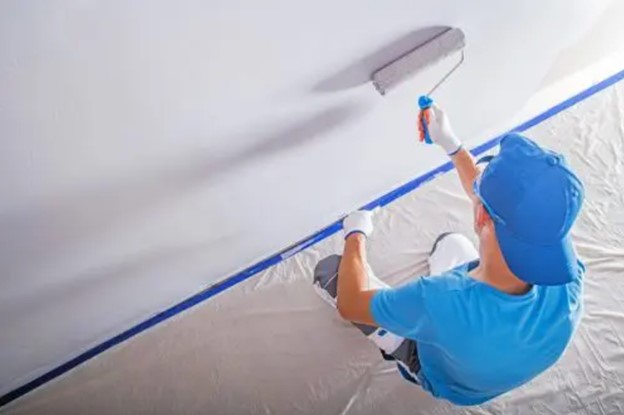An interior painting project opens up exciting possibilities for your home. Which colors will you choose? How will they affect the atmosphere of a room and the beauty of your home? Along with answering these critical questions, you need to make sure you’re preparing each room properly for a paint job.
Hiring a high-quality residential painter guarantees that you won’t neglect the steps necessary for preparing your interior spaces. Before applying any paint, what will a contractor do for room preparation?
Preparing a Room for a Residential Painting Project
Move Furniture Out of the Way
The main reason to move furniture is to protect each piece from the damage caused by splatters of paint and other substances. Another reason is that furniture is an obstacle that keeps your painter from easily reaching different surfaces.
Sometimes, you’ll have to clear all of the furniture out of a room. Other times, it may be enough to move furniture to the opposite side of the room or to the center, away from the walls. What you’ll need to do depends on the square footage of a room and how much of it you’re painting. Your interior painter will help you figure out the best way to temporarily relocate your furniture.
Protect the Floors and Furniture
Drop cloths and plastic sheeting are among the items professional interior painters rely on to shield different parts of a room. Any furniture that hasn’t been moved away needs protection from dripping or splattering paint. As for your floors, paint stains may cause permanent damage or demand laborious cleaning techniques for removal. It’s best to take a preventative approach and cover the floor instead.
Remove Outlet Covers and Electrical Switch Plates
During do-it-yourself projects, this step sometimes gets neglected, even though it’s necessary for achieving a clean, even look. With professional residential painters, you won’t have to worry. Along with protecting the light fixtures in your room, they’ll temporarily remove covers and switch plates. They’ll also wait the right amount of time before reinstalling these items.
Perform Repairs
A paint job can make the flaws on a surface stand out more. If you’re painting a wall, for example, any cracks or holes will likely become more noticeable after you’ve applied a fresh coat of paint.
A residential painting contractor will be able to perform various minor repairs prior to a paint job. They’ll fix holes and cracks, replace drywall tape, and smooth out rough or uneven surfaces.
They’ll also let you know if they discover a more serious issue with your home. For example, they may spot signs of a plumbing leak in your walls or ceiling. In that case, they’ll discuss your options with you and help you make the best decision about how to address the problem.
Thoroughly Clean the Surfaces
A paint job won’t succeed when applied to dirty surfaces. The paint won’t look as beautiful or last as long as it would on a clean surface.
If moving your furniture out of the way has kicked up dust, you’ll need to clean it off your walls. The same goes for other substances, including food stains, grease, mildew, soot, dirt, and fingerprint smudges.
Your painter will make sure each surface is sufficiently clean. Sometimes, the cleaning will simply involve some mild soap and water. Other times, the cleaning will call for stronger chemical mixtures and special equipment.
After a cleaning, it’s important to let the surface dry before starting the paint job. For each surface, your interior painter will know how long to wait.
Use Painter’s Tape
Painter’s tape serves two main purposes:
It helps keep wet paint from running onto different surfaces that aren’t part of the paint job. Window sills, baseboards, molding, and other features around the room enjoy enhanced protection.
It helps painters maintain straight lines. Your paint job winds up looking more even and clean.
Painter’s tape shouldn’t be confused with regular masking tape. The regular kind will likely leave behind a residue on your walls or other surfaces. It also doesn’t serve as well at blocking runny paint.
You can trust your interior painting contractor to work with a high-quality painter’s tape and know how to apply it. In amateur paint jobs, the tape often gets overused, applied unevenly, left on for too long, or removed messily. With professional paint services, you won’t have to worry about these problems.
Apply Primer
Your painter will help you determine whether or not you need to use primer on a particular surface. Primer can strengthen the longevity of a paint job and enhance its appearance, making the fresh paint look uniform and free of blemishes.
If you do need some primer, your interior painter will know how to apply it effectively. Different surfaces, such as drywall or masonry, will require different kinds of primer. Furthermore, the primer needs to dry properly before the application of paint.
Work Cleanly
At this point, the painting work can begin. Your painter will organize a staging area either in the room or immediately outside of it. In this spot, they’ll prepare the paints and other substances, store their open paint cans, and clean their equipment.
Searching Painters Near Me? Contact LRM Painting
For high-quality interior painting, don’t hesitate to reach out to us. If you live in or around Macomb County MI, we’re available to transform your home and increase its beauty and value.
When you contact us 586-615-9329 or through our site, you can expect a swift response. We’ll discuss paint options and color schemes with you and ensure that you’re making the best decisions for your home. You can also depend on us to respect your budget and schedule our project in a way that’s most convenient for you. Count on us to deliver outstanding residential painting projects.


Recent Comments